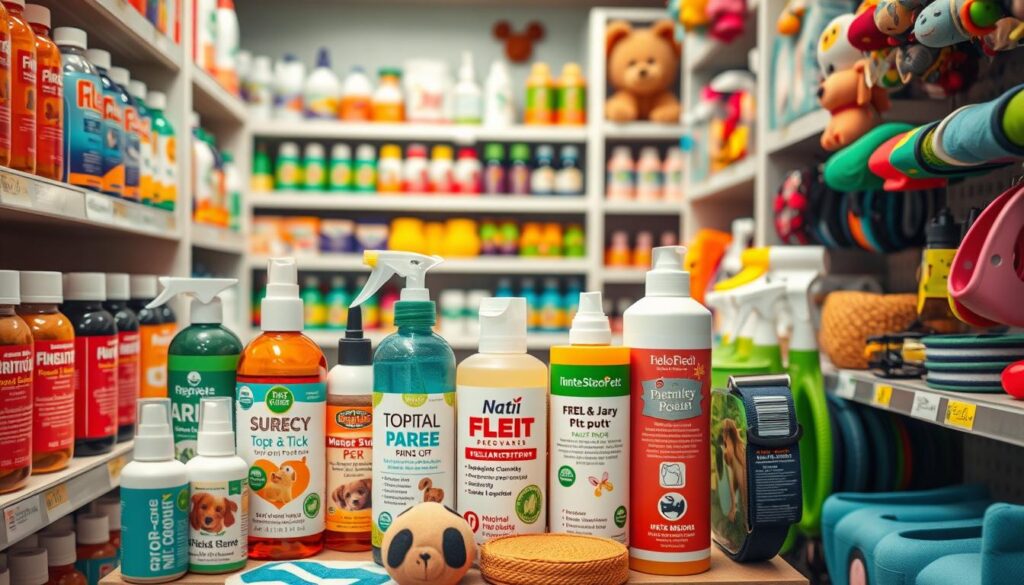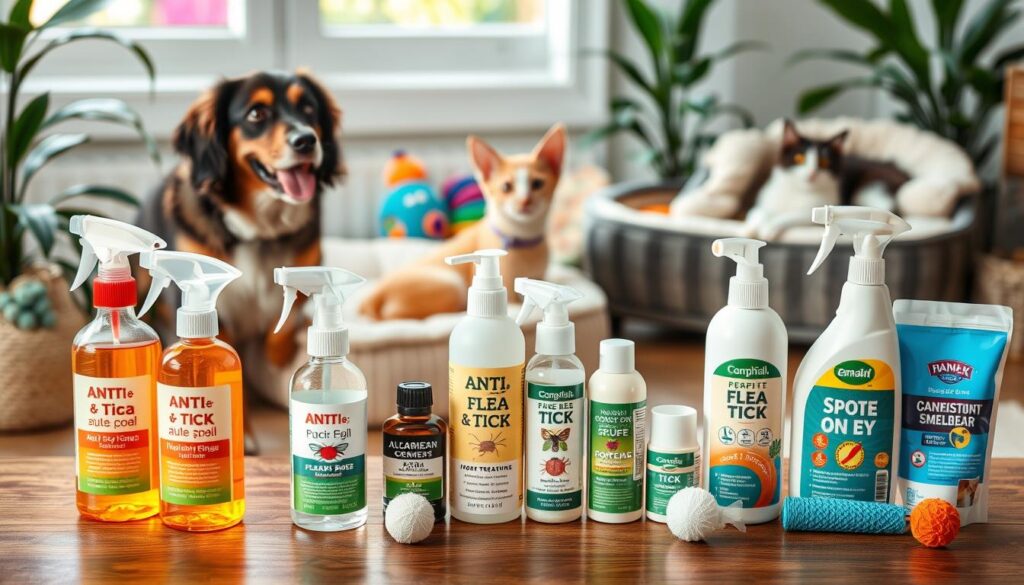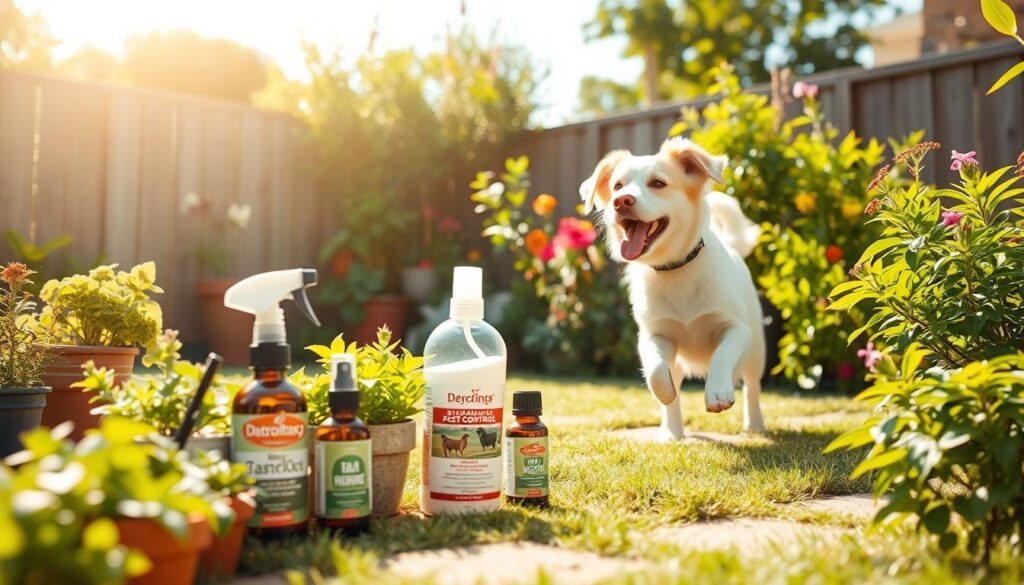Keeping our pets safe from fleas and ticks is very important. These pests can make our pets uncomfortable and even sick. Luckily, there are many anti-flea and tick preparations to keep them safe. Pets Safe
There are many options like pet grooming products, insect repellents, veterinary medicines, and pest control solutions. This guide will help you understand these options. We’ll talk about their benefits and how to keep your pet safe. Pets Safe

Key Takeaways
- Fleas and ticks are a big health risk for pets, so regular pest control is key.
- Anti-flea and tick preparations come in many forms, like topical solutions, oral meds, and flea collars.
- It’s important to know the different types and how well they work to choose the best one for your pet.
- Following the right application and safety guidelines is crucial for using pest control products safely and effectively.
- Using a mix of prevention methods, like treating the environment and grooming, can offer the best protection.
Understanding Anti-Flea and Tick Preparations: Types and Benefits
Keeping your pets safe from fleas and ticks is key. There are many effective treatments available. Each has its own benefits and ways to use them. Let’s look at the different options to help you choose the best for your pet.
Topical Solutions and Their Application
Topical treatments, or spot-on treatments, are a favorite for many. They are liquids applied to the pet’s skin, usually between the shoulders or at the neck. These solutions release ingredients that repel and kill pests, protecting your pet for a long time. It’s important to apply them correctly for the best results.
Oral Medications and Duration of Protection
Oral medications are another good choice. These are chewable or tablets that your pet takes. The ingredients spread through the blood to protect your pet. How long they last varies, so talk to your vet to find the right one for your pet.
Flea Collars and Their Effectiveness
Flea collars are easy to use and last a long time. They release ingredients that protect your pet for months. While they work well, how well they do depends on the product and your pet’s environment. Always follow the instructions and watch how your pet reacts for the best protection.
Knowing about anti-flea and tick treatments is important for your pet’s safety. By looking at topical solutions, oral medications, and flea collars, you can find the best fit for your pet and your needs.
| Treatment Type | Application Method | Duration of Protection | Key Benefits |
|---|---|---|---|
| Topical Solutions | Applied directly to the skin | Long-lasting (typically 1-3 months) | Convenient, effective, and water-resistant |
| Oral Medications | Chewable or tablet form | Varies (from a few weeks to several months) | Systemic protection, easy administration |
| Flea Collars | Worn around the pet’s neck | Long-lasting (typically 6-8 months) | Continuous protection, convenient |
Choosing the right treatment for your pets is crucial. There are many options, each with its own benefits. By understanding these, you can make a smart choice to keep your pets safe and happy.
Natural vs Chemical Treatment Options for Pet Protection
Choosing between natural remedies and chemical treatments for pets is a big decision. Both have their good and bad sides. Knowing the differences helps pet owners make the best choice.
Natural remedies like essential oils and herbs are popular for pet wellness. They promise to keep fleas and ticks away without harming pets or the environment. Fans of natural solutions say they are kinder to pets’ skin.
| Natural Remedies | Chemical Treatments |
|---|---|
| Gentle on pets’ skin Potentially safer for the environment May not be as effective as chemical treatments Require more frequent application | Highly effective in killing and repelling fleas and ticks Provide longer-lasting protection May cause adverse reactions in some pets Potential environmental concerns |
Chemical-based treatments like topical solutions and oral meds are known for their strong preventative care. They are effective against parasitic infestations. These pet insecticides offer long-lasting protection, making them a favorite among pet owners.
The choice between natural and chemical treatments depends on what’s best for the pet and the owner. Talking to a vet can help make the right decision for our pets’ safety and health.

Essential Safety Guidelines for Using Pest Control Products
Protecting your pets from fleas, ticks, and pests is key. It’s important to know how to use veterinary products safely. This includes understanding how to apply them and what to do if your pet has a bad reaction.
Proper Application Techniques
Always read the label on pet care essentials products. Make sure to use the right amount for your pet’s size and weight. Don’t put it near their eyes, nose, or mouth.
Apply the product evenly but don’t use too much. This helps keep your pet safe and healthy.
Signs of Adverse Reactions
Watch your pet closely after using animal health care treatments. Look for signs like too much scratching, redness, or swelling. If you see any of these, stop using the product and talk to your vet.
Emergency Response Protocols
- If your pet eats a veterinary medication or has a bad reaction, call your vet or an animal poison control center right away.
- Have the product info ready, including the active ingredients. This helps the experts give the right treatment.
- Do what the product label says to do first until you can get to a vet.
Remember, your pets’ health and safety are most important when using pet parasite prevention products. By following these guidelines, you can keep your pets safe and happy.

Seasonal Timing and Treatment Frequency for Maximum Protection
Keeping up with preventative pet care is vital against fleas and ticks. Their activity changes with the seasons, so pet owners must adjust their flea and tick control plans. Knowing when and how often to treat your pet is crucial for year-round protection.
Flea and tick numbers often rise in warmer months, starting in early spring and peaking in summer. This makes it key to start preventative pet care early. Experts suggest starting flea and tick control a month before the peak to keep your pet safe.
For furry friend care, a plan for all seasons is best. Depending on where you live and your pet’s habits, your vet might suggest monthly or quarterly treatments. Sticking to these schedules is important to keep your pet safe from pests.
| Season | Pest Activity | Recommended Treatment Frequency |
|---|---|---|
| Spring | Increased flea and tick populations | Monthly preventative pet care treatments |
| Summer | Peak flea and tick activity | Monthly flea and tick control treatments |
| Fall | Gradually declining pest activity | Quarterly pest control for animals treatments |
| Winter | Lower flea and tick populations | Quarterly veterinary insect repellents treatments |
Matching your furry friend care plan with flea and tick seasons helps keep your pet safe all year. This way, they can enjoy the outdoors without worrying about pests.
“Consistent, year-round flea and tick control is the key to keeping your pet safe and healthy.”

Combining Prevention Methods for Complete Pest Control
To fight fleas and ticks, you need a plan that uses many methods. This includes treating the environment, grooming your pets, and keeping your home clean. Together, these steps help protect your pets from these pests.
Environmental Treatment Strategies
It’s important to treat the places where your pets hang out. Use pest control products in your yard, garden, and outdoor spots. Also, treat your home with household insecticide to stop pests from breeding.
Grooming Practices That Support Prevention
Using pet grooming supplies and flea control products is key. Regular baths, brushing, and flea collars or anti-flea and tick solutions can stop fleas and ticks in their tracks.
Home Maintenance Tips
Keeping your home clean helps fight pests. Vacuum often, wash your pet’s bedding, and get rid of places where fleas and ticks hide. Catching any pest problems early is crucial to keep your home safe for your pets.
By using all these methods, you can keep your pets safe from fleas and ticks. A mix of treatments, grooming, and home care is the best way to keep your pets healthy and happy.

| Prevention Method | Benefits |
|---|---|
| Environmental Treatments | Eliminate breeding grounds and disrupt the life cycle of fleas and ticks |
| Grooming Practices | Remove and repel parasites, support overall pet health |
| Home Maintenance | Prevent infestations by denying pests a suitable environment |
Conclusion
Keeping our pets safe from fleas and ticks is key to their health. There are many ways to protect them, like topical treatments, oral meds, and flea collars. These anti-flea and tick preparations give us choices to fight these pests.
Choosing between natural and chemical treatments is important. Always follow safety rules and talk to your vet to find the best option for your pet. It’s crucial to use these products correctly and watch for any bad reactions.
Combining prevention methods is the best way to protect pets. This includes treating the environment, regular grooming, and keeping the home clean. By being informed and proactive, we can keep our pets safe and healthy. This strengthens the bond between pets and their owners, making their lives better.
FAQ
What are the different types of anti-flea and tick preparations available for pets?
There are several types of anti-flea and tick treatments for pets. Topical solutions are applied to the skin. Oral medications are taken by mouth. Flea collars release active ingredients over time.
How do I properly apply topical flea and tick treatments?
To apply topical solutions, follow the instructions closely. Part your pet’s fur and apply the product to the skin. Avoid the eyes, mouth, and areas they may lick. Watch for any bad reactions after use.
How long do oral flea and tick medications provide protection?
Oral medications usually protect for 30 days. Always check with your vet for the right dosage and how often to use it.
Are flea collars an effective way to prevent infestations?
Flea collars can work, but their success depends on the product and your pet. They release ingredients to repel and kill fleas and ticks. But, they might not be as effective as other treatments.
What are the benefits of using natural remedies for flea and tick prevention?
Natural remedies, like essential oils, are gentler on pets and the environment. They’re a good choice for those who want to avoid synthetic chemicals. But, make sure to research their safety and effectiveness first.
How can I tell if my pet is having an adverse reaction to a flea or tick treatment?
Look for signs like too much scratching, redness, swelling, or being very tired. If you see these, stop using the product and talk to your vet.
What is the best time of year to apply flea and tick treatments?
The best time to apply treatments depends on where you live and the weather. It’s usually best to protect your pet all year. Talk to your vet about the best schedule for your pet’s lifestyle and local pests.
How can I combine different prevention methods for comprehensive pest control?
For complete pest control, use a mix of methods. This includes topical or oral treatments, environmental sprays or powders, and regular grooming and cleaning. This approach targets both your pet and their environment to stop fleas and ticks.




 No products in the cart.
No products in the cart.